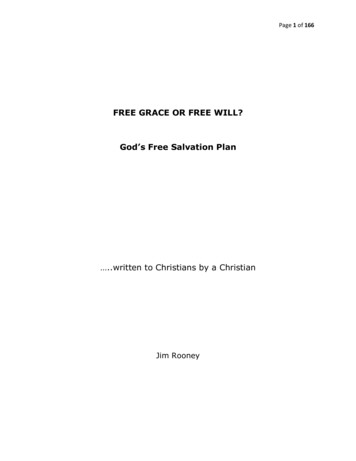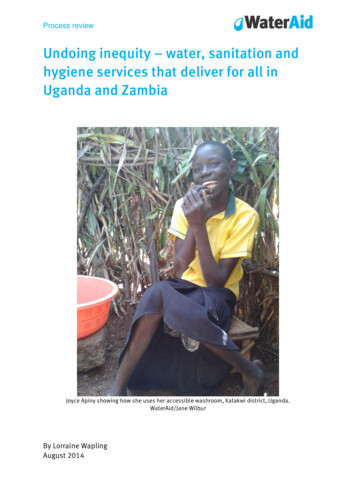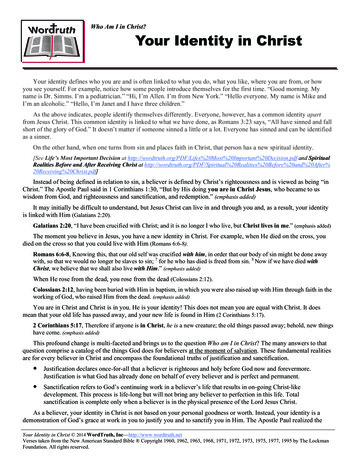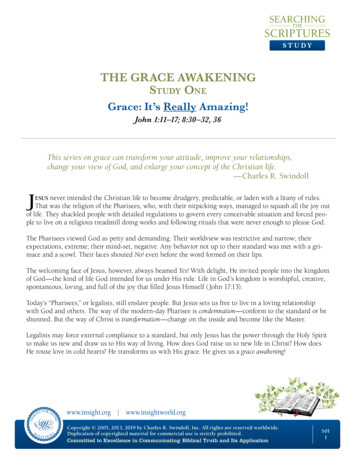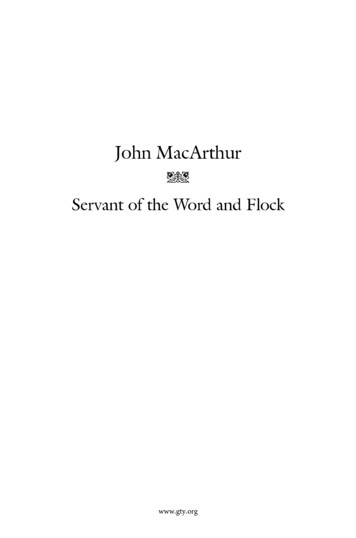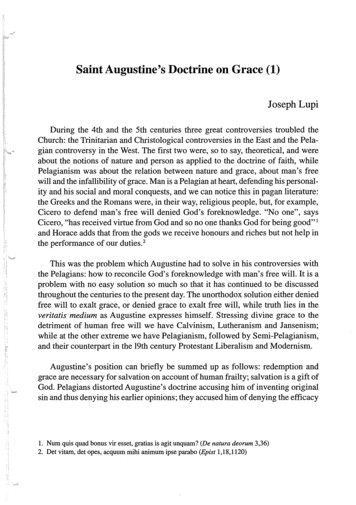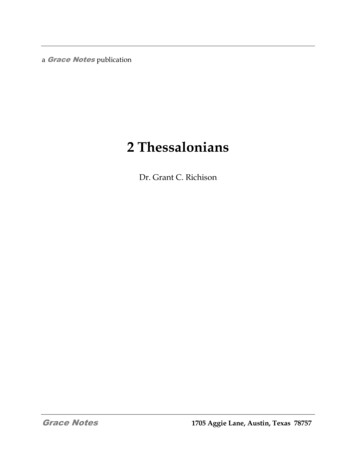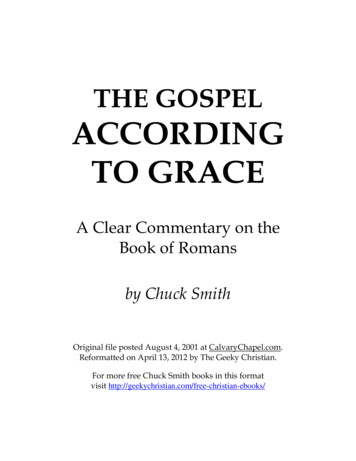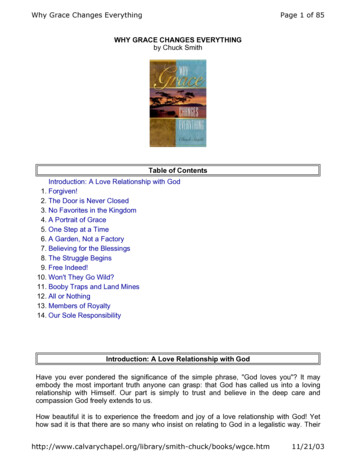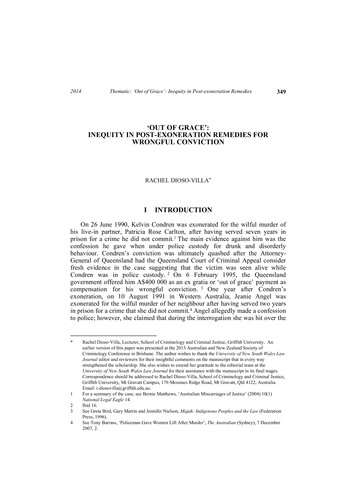
Transcription
2014Thematic: ‘Out of Grace’: Inequity in Post-exoneration Remedies349‘OUT OF GRACE’:INEQUITY IN POST-EXONERATION REMEDIES FORWRONGFUL CONVICTIONRACHEL DIOSO-VILLA*IINTRODUCTIONOn 26 June 1990, Kelvin Condren was exonerated for the wilful murder ofhis live-in partner, Patricia Rose Carlton, after having served seven years inprison for a crime he did not commit.1 The main evidence against him was theconfession he gave when under police custody for drunk and disorderlybehaviour. Condren’s conviction was ultimately quashed after the AttorneyGeneral of Queensland had the Queensland Court of Criminal Appeal considerfresh evidence in the case suggesting that the victim was seen alive whileCondren was in police custody. 2 On 6 February 1995, the Queenslandgovernment offered him A 400 000 as an ex gratia or ‘out of grace’ payment ascompensation for his wrongful conviction. 3 One year after Condren’sexoneration, on 10 August 1991 in Western Australia, Jeanie Angel wasexonerated for the wilful murder of her neighbour after having served two yearsin prison for a crime that she did not commit.4 Angel allegedly made a confessionto police; however, she claimed that during the interrogation she was hit over the*1234Rachel Dioso-Villa, Lecturer, School of Criminology and Criminal Justice, Griffith University. Anearlier version of this paper was presented at the 2013 Australian and New Zealand Society ofCriminology Conference in Brisbane. The author wishes to thank the University of New South Wales LawJournal editor and reviewers for their insightful comments on the manuscript that in every waystrengthened the scholarship. She also wishes to extend her gratitude to the editorial team at theUniversity of New South Wales Law Journal for their assistance with the manuscript in its final stages.Correspondence should be addressed to Rachel Dioso-Villa, School of Criminology and Criminal Justice,Griffith University, Mt Gravatt Campus, 176 Messines Ridge Road, Mt Gravatt, Qld 4122, Australia.Email: r.diosovilla@griffith.edu.au.For a summary of the case, see Bernie Matthews, ‘Australian Miscarriages of Justice’ (2004) 10(1)National Legal Eagle 14.Ibid 16.See Greta Bird, Gary Martin and Jennifer Nielson, Majah: Indigenous Peoples and the Law (FederationPress, 1996).See Tony Barrass, ‘Policeman Gave Women Lift After Murder’, The Australian (Sydney), 7 December2007, 2.
350UNSW Law JournalVolume 37(1)head with a bottle before signing the written confession. 5 Her conviction wasquashed as unsafe and unsatisfactory after two other women who had beendrinking with the deceased admitted that they hit her several times over the headwith a stick and later hid the body in the bushes.6 In contrast to Kelvin Condren’scase, Jeanie Angel did not receive compensation for her wrongful conviction;instead the Attorney-General of Western Australia rejected her request for an exgratia payment saying that ‘[a]n act of grace [ex gratia] payment is made only inthe most exceptional circumstances, and this is not such a case.’7These examples raise questions about the application and adequacy of exgratia payments as a means of compensating for the loss, harm or injury thatwrongfully convicted persons endure due to their convictions and subsequentimprisonment.8 These payments are not awarded to all who have been pardonedor have had their convictions quashed, since there is no state or federal indemnitylegislation in place that explicitly address the needs of those wrongfullyconvicted in Australia. 9 In the absence of indemnity legislation for wrongfulconviction, exonerees may seek recourse through specialised bills to compensateindividuals, civil litigation against liable parties, or ex gratia ‘out of grace’payments.10 Due to the difficulty and rarity of pursuing compensation throughparliament and the courts,11 ex gratia is the most commonly utilised and viableoption for individuals who seek redress for wrongful conviction andincarceration.12Over the past century, legal scholars have argued for the establishment ofcompensation statutes for wrongful conviction in common law countries around56789101112Ibid.See Tony Barrass, ‘No Cash for Aboriginal Woman Jeanie Angel Wrongly Jailed’, The Australian(online), 3 June 2008 0126 .Duncan Graham, ‘Jailed Woman Deserves Pay-Out: Tickner’, Sydney Morning Herald, 15 July 1993, 3.See Christine E Sheehy, ‘Compensation for Wrongful Conviction in New Zealand’ (1999) 8 AucklandUniversity Law Review 977, 983–4.With the exception of the ACT, discussed in Part II below. See Adrian Hoel, ‘Compensation forWrongful Conviction’ (Trends and Issues in Crime and Criminal Justice Research Paper No 356,Australian Institute of Criminology, May 2008).See ibid; Rachel Dioso-Villa, ‘Without Legal Obligation: Compensating the Wrongfully Convicted inAustralia’ (2012) 75 Albany Law Review 1329, 1334–8.See Part II below.See Dioso-Villa, above n 10 (analysing successful and unsuccessful ex gratia petitions for wrongfulconviction in Australia and identifying salient factors that can influence the decision-making process andthe allocation of payments).
2014Thematic: ‘Out of Grace’: Inequity in Post-exoneration Remedies351the world with some success;13 however, there are limited studies that argue forsuch laws within the Australian context or that have evaluated the adequacy ofexisting remedies to aid exonerees in their successful reintegration into society.14This article attempts to fill this gap by examining the application of ex gratiapayments as compensation for wrongful conviction and asking the questions: (1)Are ex gratia payments a suitable remedy for exonerees? (2) Does the state havean obligation to exonerees to provide redress for the injury or loss theyexperience from their imprisonment? (3) If ex gratia is not an adequate measure,why might this be the case? (4) What may Australia do to address the needs ofthe wrongfully convicted post-exoneration? Because the definition of a ‘wrongfulconviction’ may encompass many situations, it is used in this article to refer tocases where individuals have been sentenced to a term of imprisonment and havehad their sentences quashed on appeal; were acquitted at retrial; had their verdictsconsidered unsafe and their convictions vacated; or have received a pardon.The article begins by outlining compensation remedies available to exonereesin Australia with a focus on ex gratia payments. I draw on my earlier work thatexamined the circumstances in which ex gratia payments were awarded anddenied for wrongful conviction 15 and provide a summary of these findings toidentify key criticisms about the existing structure and application of ex gratiapayments as a principal remedy for wrongful conviction in Australia. 16 I thenconsider the role of the state in providing compensation for errors of justice as amoral and legal duty and question whether discretionary acts create unintendedequity issues for exonerees who seek compensation. The article concludes withrecommendations to improve the situation for the wrongfully convicted inAustralia who wish to seek redress, namely the creation of comprehensivecompensation legislation for wrongful conviction, extended post-appeal review,and the establishment of a review commission to investigate potential wrongfulconviction cases.13141516See Edwin M Borchard, ‘European Systems of State Indemnity for Errors of Criminal Justice’ (1913) 3Journal of the American Institute of Criminal Law and Criminology 684; Edwin M Borchard, ‘StateIndemnity for Errors of Criminal Justice’ (1941) 21 Boston University Law Review 201; Adele Bernhard,‘When Justice Fails: Indemnification for Unjust Conviction’ (1999) 6 University of Chicago Law SchoolRoundtable 73; Jennifer L Chunias and Yael D Aufgang, ‘Beyond Monetary Compensation: The Needfor Comprehensive Services for the Wrongfully Convicted’ (2008) 28 Boston College Third World LawJournal 105; Jessica R Lonergan, ‘Protecting the Innocent: A Model for Comprehensive, IndividualizedCompensation of the Exonerated’ (2008) 11 Legislation and Public Policy 405; Shawn Armbrust, ‘WhenMoney Isn’t Enough: The Case for Holistic Compensation of the Wrongfully Convicted’ (2004) 41American Criminal Law Review 157.But see Hoel, ‘Compensation for Wrongful Conviction’, above n 9; Dioso-Villa, above n 10.Dioso-Villa, above n 10, 1369–71. Table 1, below, lists individuals in Australia exonerated between 1956and 2011.Despite the fact that ex gratia payments are discretionary by nature, in this article, I elect to frame exgratia payments as a ‘remedy’ for wrongful conviction and imprisonment, consistent with researchdiscussing the options available to exonerees to seek redress for harm or loss experienced as a result ofthe wrongful conviction: see Sheehy, above n 8; Lonergan, above n 13.
352UNSW Law JournalVolume 37(1)II COMPENSATION FOR WRONGFUL CONVICTION INAUSTRALIACurrently, wrongfully convicted individuals do not automatically receivecompensation in Australia. In most Australian jurisdictions other than theAustralian Capital Territory,17 these individuals do not have a common law orstatutory right to compensation for their wrongful conviction or imprisonment.18Australia is a signatory to the ICCPR 19 that outlines compensation for thewrongfully convicted. However, Australia has yet to incorporate this as a rightinto domestic law20 and maintains the position that this provision gives rise toadministrative procedures, rather than legal provisions. 21 Article 14(6) of theICCPR states:When a person has by a final decision been convicted of a criminal offence andwhen subsequently his conviction has been reversed or he has been pardoned onthe ground that a new or newly discovered fact shows conclusively that there hasbeen a miscarriage of justice, the person who has suffered punishment as a resultof such conviction shall be compensated according to law, unless it is proved thatthe non-disclosure of the unknown fact in time is wholly or partly attributable tohim.22This compensation scheme has had varying degrees of success in itsapplication. 23 One criticism is that ‘miscarriage of justice’ in this context hasbeen narrowly interpreted to include only those who have been exonerated asfactually innocent, rather than innocent individuals who have had theirconvictions quashed because the verdict was considered unsafe on appeal.24 Bylimiting applicants’ eligibility to the factually innocent, this understanding of amiscarriage of justice may miss its intended purpose, which is to provide alegislated entitlement to compensation for individuals who have been convicted17The ACT has incorporated the International Covenant on Civil and Political Rights (‘ICCPR’) art 14(6)in the Human Rights Act 2004 (ACT) s 23. The section for compensation for wrongful conviction appliesif:(a) anyone is convicted by a final decision of a criminal offense; and (b) the person suffers punishmentbecause of the conviction; and (c) the conviction is reversed, or he or she is pardoned, on the ground that anew or newly discovered fact shows conclusively that there has been a miscarriage of justice. If thissection applies, the person has the right to be compensated according to law [unless] it is proved that thenondisclosure of the unknown fact in time is completely or partly the person’s own doing.18192021222324See Hoel, ‘Compensation for Wrongful Conviction’, above n 9, 2–3.Opened for signature 16 December 1966, 999 UNTS 1057 (entered into force 23 March 1976).Dioso-Villa, above n 10, 1336.See Hoel, ‘Compensation for Wrongful Conviction’, above n 9, 2.ICCPR art 14(6).See Hannah Quirk and Marny Requa, ‘The Supreme Court on Compensation for Miscarriages of Justice:Is It Better That Ten Innocents Are Denied Compensation Than One Guilty Person Receives It?’ (2012)75 Modern Law Review 387. They demonstrate that in the United Kingdom, there has been a decline inthe number of applications received and approved for compensation for miscarriages after the abolition ofthe ex gratia scheme in 2006 and the increased subsequent reliance on the Criminal Justice Act 1988(UK) c 33, s 133, that is based on the ICCPR art 14(6).See Stephanie Roberts, ‘“Unsafe” Convictions: Defining and Compensating Miscarriages of Justice’(2003) 66 Modern Law Review 441; Quirk and Requa, above n 23.
2014Thematic: ‘Out of Grace’: Inequity in Post-exoneration Remedies353and imprisoned for crimes they did not commit. 25 Therefore, those innocentindividuals who have received pardons or who have had their convictionsquashed, reversed, vacated or dismissed, must seek alternative avenues of redresssuch as seeking compensation through ex gratia schemes.In the absence of federal, state or territory compensation legislation, a statemay award ‘out of grace’ payments as ex gratia compensation withoutexplanation and without setting precedent.26 These payments are generally madeand calculated according to the actual damage or loss incurred from the act(s) orevent(s) in question. 27 States have awarded ex gratia payments in the past toclasses of victims such as wrongfully convicted individuals as well as victims ofnatural disasters, 28 although each case is considered independently on its ownmerit.29 The state has no legal obligation to award payments and the decision ishighly discretionary30 and often rests in the hands of an executive power, such asan attorney-general, who may or may not reach a decision in consultation withothers.31Currently, there are no guidelines to assist governors or attorneys-general inmaking decisions to award or deny ex gratia payments for wrongful conviction.32There are, in some jurisdictions, principles that these executives may considerwhen administering ex gratia payments to persons who have ‘suffered a financialloss or other detriment directly as a result of the workings of [g]overnment,’33which would encompass those who seek compensation for wrongful conviction.Two such principles are to have applicants provide evidence of a clear andverifiable loss and provide evidence of fault or error by a state actor that is252627282930313233See Quirk and Requa, above n 23, 390. As they discuss, another equally valid intended purpose of thelegislation is not to compensate individuals who have been imprisoned for crimes they did commit. Thedifficulty with including quashed sentences as a miscarriage of justice is that a quashed sentence does notnecessarily mean that the person did not commit the crime.See Hoel, ‘Compensation for Wrongful Conviction’, above n 9, 2–3.See Sheehy, above n 8, 979.The Australian Government Disaster Recovery Payment Program was available to individuals adverselyaffected by the Queensland flooding from November 2010 to January 2011. Ex gratia payments were alsoavailable for New Zealanders affected by the flooding: Australian Government Disaster Assist,Queensland Floods (November 2010 - February 2011): Australian Government Expenditure forQueensland Floods (4 September 2013) 1).aspx#gratia .Each application is considered on its merits and decisions do not create precedents: see Department ofFinance and Deregulation, ‘Review of Government Compensation Payments’ (Submission No 92 toSenate Standing Committee on Legal and Constitutional Affairs, Parliament of Australia, 11 June 2010)5.See Sheehy, above n 8, 979.See John McMillan, ‘Executive Schemes’ (Report No 12 of 2009, Commonwealth Ombudsman, August2009) 7.See Hoel, ‘Compensation for Wrongful Conviction’, above n 9, 3 (discussing guidelines as they mayapply to ex gratia payments in Australia). See also Adrian Hoel, ‘The Imperfect Crime: Dealing withWrongful Conviction’ (2008) 33 Alternative Law Journal 252.Justice Legal, Ex Gratia Payments (19 August 2012) New South Wales Lawlink http://www.lsb.lawlink.nsw.gov.au/lsb/legal services appl costs/legal services exgratia pay.html .
354UNSW Law JournalVolume 37(1)directly responsible for the loss.34 However, these principles are not formal, normandatory criteria to receive payments, since each case is considered on its ownmerits and payments are not guaranteed even when the applicant addresses allprinciples.35Another option for exonerees is to raise a civil suit against state actors whowere instrumental in the wrongful conviction during the investigation or at trial.36In cases with evidence of gross state misconduct, such as a coerced confessionelicited during a police interrogation, fraudulent forensic evidence, orprosecutorial misfeasance, an exoneree may pursue civil litigation againstindividual police officers, a laboratory, or the prosecutors responsible for theirfalse imprisonment. Successful tortious claims are rare,37 given the difficulty indemonstrating that the public officer acted with malice against the exoneree andthat this resulted in his or her wrongful conviction and subsequent suffering.38This is especially the case when a person may be wrongfully convicted withoutmalice or ill intent.39 Moreover, not all exonerees have the legal and financialresources required to pursue tortious action and the time required to build thecase to its final outcome may be too lengthy given the already acute lossesexperienced while imprisoned.40Exonerees may also seek compensation by drafting an individualised bill topass through state legislature for direct compensation for injuries or lossexperienced as a result of the wrongful conviction.41 This is the least pursuedremedy since it requires legal support to draft the bill and political support tomarshal a politician to lobby the bill in parliament.42 Success of such private billsmay depend on the political climate of parliament at the time the bill is proposedand the clout or authority of the politician presenting the bill, rather than themerits of the bill itself.43 Given the legal, political, and financial requirementsrequired to carry this out, it is unlikely that this is a viable option for mostexonerees. There is also no guarantee that the bill will pass and the time it wouldtake to secure funding may extend far beyond the point at which it is needed.443435363738394041424344Ibid.Ibid.See Sheehy, above n 8, 978–83 (discussing traditional remedies for wrongfully convicted individuals).See also Dioso-Villa, above n 10, 1334–8 (discussing compensation remedies for the wrongfullyconvicted in Australia).Dioso-Villa, above n 10, 1372 (see Figure 1, which shows the compensation outcomes for exonerees inAustralia). See also Sheehy, above n 8, 980–1 (outlining what is needed to file a civil litigation suit forwrongful conviction and stating its rarity due to the stringency of the requirements).See Sheehy, above n 8, 981 (discussing the difficulty in demonstrating malicious prosecution in wrongfulconviction cases).Ibid.Ibid (discussing tortious remedies for wrongful convictions).Ibid 982; Dioso-Villa, above n 10, 1338.See Bernhard, ‘When Justice Fails’, above n 13, 94.Ibid; Michael Leo Owens and Elizabeth Griffiths, ‘Uneven Reparations for Wrongful Convictions:Examining the State Politics of Statutory Compensation Legislation’ (2012) 75 Albany Law Review 1283,1296–7; Armbrust, above n 13, 166.See Sheehy, above n 8, 982.
2014Thematic: ‘Out of Grace’: Inequity in Post-exoneration Remedies355III EX GRATIA PAYMENTS FOR WRONGFUL CONVICTIONIN AUSTRALIAIn an earlier work, I compiled a dataset of 57 known cases of wrongfulconvictions 45 in Australia based on secondary sources including academicarticles, legal databases, newspaper articles and wrongful conviction websites.46Because there is no centralised resource that compiles this information, thesecases are a sample of wrongful convictions in Australia rather than an exhaustivelist of all cases. 47 The cases ranged from 1922 to 2008 and correspondingexonerations from 1956 to 2011. The sentences ranged from one year to lifeimprisonment, while time served in prison ranged from two and a half months to15 years, with an average of four and a half years spent in prison before releaseand exoneration.48 Over half of the sample (58 per cent) sought some form ofcompensation in the form of requesting an ex gratia payment, lodging aspecialised bill in parliament or pursuing a civil lawsuit for loss and damages forthe wrongful conviction and imprisonment (see Table 1). 49 Nearly half of theexonerees in the sample petitioned for compensation through ex gratiaapplications to the state (47 per cent).50 Of these, almost two-thirds (63 per cent)were successful in receiving some form of compensation through ex gratiapayments made by the state. Seven out of the 57 exonerees filed a civil suit, ofwhich three were successful. In other words, five per cent of the total sample ofknown wrongful convictions in Australia received some form of compensationfor wrongful conviction and imprisonment via civil litigation. Only one exonereehad a specialised bill drafted and lodged in parliament regarding compensation.51Since few exonerees in the sample filed civil suits and only one individualpursued compensation through an individualised bill, filing ex gratia applicationsis by far the most sought after post-exoneration remedy in Australia.45464748495051‘Wrongful convictions’ were identified as (1) individuals who have had their sentences quashed atappeal; (2) individuals who were acquitted at retrial; (3) cases where the verdict was considered unsafeand the conviction was vacated; and (4) individuals who received a pardon.For a description of the dataset and the methodology employed to create it, see Dioso-Villa, above n 10,1338–41.For a listing of cases compiled, see ibid 1369–71.Ibid.For the remaining 24 cases (48 per cent), I could not locate evidence that indicated that they had appliedfor compensation, however, this does not necessarily account for civil suits settled out of court that werenot made public or disclosed to media sources, or those who sought redress after the point of datacollection.Specifically, 27 out of 57 of the sample pool of exonerees filed an ex gratia claim before 2011.Douglas Harry Rendell had a specialised Bill lodged on his behalf to the NSW Parliament petitioning thata judge, rather than a political executive, assess the compensation payment due to his dissatisfaction withthe amount offered by the Attorney-General. However, it must be noted that he later accepted the amountoriginally offered by the Attorney-General. The Bill passed with the Crimes Legislation (Review ofConvictions) Amendment Bill 1993.
356UNSW Law JournalVolume 37(1)Table 1: Compensation Outcomes for Known Exonerations in Australia from 1956 to 2011Awarded/SuccessfulDenied/FailedDecision PendingTotalEx Gratia178227Civil Lawsuits3407Specialised Bill1*001Unknown------24* Note: The specialised bill in this case was submitted to Parliament to address the fairness in determiningthe appropriate amount of compensation, such that a judge, rather than a political officer should make thedetermination.In response to the absence of specific guidelines for issuing ex gratiapayment for wrongful conviction, each case and its corresponding compensationoutcome was reviewed to identify any common case characteristics or factorscommon to ex gratia awards. 52 Ex gratia payments were often found to beawarded in cases with new evidence discovered after conviction; 53 grossmisconduct by state officials; high profile cases; where the applicant was able tosolicit political support for their application; or where they were themselves apolitical figure (See Table 2).54 So, although each petition for ex gratia paymentwas considered on its own merit and that there were no formal or mandatorycriteria to receive an award, the analysis showed that the presence of these factorsappeared to increase the likelihood of the applicant’s success.Table 2: Salient Factors Identified in Cases Successfully Awarded Ex Gratia Payments forWrongful ConvictionSalient Factor*DescriptionExamplesNew Evidence**New evidence discoveredpost-conviction that becameinstrumental in exonerationForensic error, perjured testimony,unsolicited confessions by trueperpetrator16/17Political SupportPolitical involvement andsupport in the reinvestigationof the casePoliticians to petition parliament forspecial inquiries on thedefendant’s behalf, when thedefendant is a political figure13/17525354Frequencyamong AwardsDioso-Villa, above n 10.‘New evidence’ in this context includes fresh evidence not available at the time of the trial and evidenceavailable at the time of the trial, but not presented in court: see Lynne Weathered, ‘Pardon Me: CurrentAvenues for the Correction of Wrongful Conviction in Australia’ (2005) 17 Current Issues in CriminalJustice 203, 210–11.See also Dioso-Villa, above n 10, 1342–53 (discussing case examples for each salient factor).
2014Thematic: ‘Out of Grace’: Inequity in Post-exoneration Remedies357High Profile/Media Media attention on the caseAttentionNews coverage of the crime,investigation, trial or defendant orjournalist-led reinvestigation of thecase11/17Gross StateMisconductCoerced confessions, grossnegligence, fraud, prosecutorialmisfeasance, police malfeasance8/17Misconduct by police, stateofficials, or prosecutors thatoccurred at investigation ortrial* Note: Salient factors are not mutually exclusive. For example, an act of gross state misconduct may haveoccurred during the investigation or at trial, but was only discovered after conviction and becameinstrumental to the person’s exoneration as new evidence.** Note: The term ‘new evidence’ includes fresh evidence discovered after trial that was unavailable at thetime of the trial and new evidence available at the time of the trial, but not presented at trial.The study also examined the rationales that state officials gave to justify theirdecisions taken from official press releases, interviews with journalists about theaward or denial, and statements made to the media during the coverage of thecase. 55 State officials justified ex gratia awards for wrongful conviction usingsimilar sentiments and themes as those found to be salient factors among awardrecipients. This included offering compensation as a gift to ease their transitionback into society,56 to correct specific misconduct by the police or prosecutionthat may have led to the wrongful conviction.57 Alternatively, they simply statedthat they made the decisions in deference (see Table 3). 58 These explanationshighlight that ex gratia payments may serve as something more than solelycompensation for the monetary loss experienced as a result of the wrongfulconviction. 59 The attorneys-general and governors offered that they may alsoserve to provide reparation to the exoneree to assist them with their successful reentry to society. In contrast, they rationalised the denial of ex gratia petitionsbased on how deserving or blameworthy the applicant was for the conviction; ifthey felt the case lacked exceptional circumstances, such as evidence of state5556575859Ibid, 1354–8 (discussing rationales given for ex gratia awards).Eg, the Attorney-General of NSW stated that the A 100 000 payment to Douglas Harry Rendell was ‘toassist his rehabilitation back into society’: New South Wales, Parliamentary Debates, LegislativeAssembly, 20 May 1993, 2440 (John Mills).Eg, the Attorney-General of WA stated that the ex gratia payment in the Mickelbergs case ‘has beenmade in consideration of the magnitude of the admitted perjury and the perversion of the course ofjustice by [a] former detective’: ABC News, Mickelbergs to Receive 1 Million Ex Gratia Payment (16January 2008) to-receive-1-million-ex-gratiapayment/1013980 .Eg, the Attorney-General of NSW received advice from the Solicitor-General in deciding compensationfor Douglas Harry Rendell: New South Wales, Parliamentary Debates, Legislative Assembly, 20 May1993, 2440 (John Mills).But see Hoel, ‘The Imperfect Crime’, above n 32, 258 (discussing a narrative where ex gratia paymentsare meant to strictly compensate for the wrongfully convicted person’s financial loss as a result of theterm of imprisonment).
358UNSW Law JournalVolume 37(1)misconduct; or they simply highlighted that the process was lawful, thoughunfortunate for the applicant convicted and incarcerated (see Table 3).Table 3: Explanations Given by State Officials to Justify Awards and Denials of Ex GratiaPayments for Wrongful Conviction for Australian ExonereesRationales for Awards:Case Examples:Without Explanation or as a ReferralLindy ChamberlainHarry RendellGift to Ease TransitionAndrew MallardHarry RendellTo Express RegretDarryl BeamishTo Correct Mistakes of the StatePeter and Ray MickelbergAwarded, but under No Legal ObligationFarah JamaAwarded, but Not to Set PrecedentJohn ButtonVincent NarkleRationales for Denials:Case Examples:Exoneree as Blameworthy or UndeservingSalvatore FazzariJose MartinezCarols PereirasLack of State MisconductKevin IbbsNon-exceptional CircumstancesJeanie AngelNot UnlawfulDavid EttridgePauline HansonIV HOW DOES EX GRATIA STACK UP?Moving this research forward, this article asks the next question of whetherex gratia sufficiently addresses compensation and reparation for wrongfulconviction in Australia. This section raises issues with the adequacy of ex gratiaas a means to remedy the consequences of wrongful conviction as an act of gracein Australia, rather than to satisfy any legal obligation to the victim. First, basedon ex-offenders’ experiences upon release,60 and exonerees’ additional ‘burdenof innocence’, 61 ex gratia, as monetary compensation, cannot address the6061See generally Saundra D Westervelt and Kimberly J Cook, Life After Death Row: Exonerees’ Search forCommunity and Identity (Rutgers University Press, 2012) (discussing the consequences of wrongfulconviction after exonerees are
exoneration, on 10 August 1991 in Western Australia, Jeanie Angel was exonerated for the wilful murder of her neighbour after having served two years in prison for a crime that she did not commit. 4 Angel allegedly made a confession to police; however, she c

